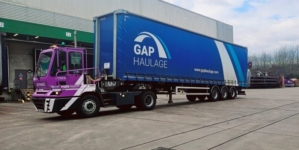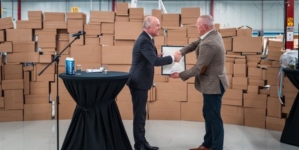-
Nutrivend selects Forterro’s Orderwise to support online expansion and streamline operations - April 11, 2025
-
ARROWXL LAUNCHES AMBITIOUS ZERO WASTE ROADMAP - April 8, 2025
-
THE BCMPA’S NEW CAMPAIGN DRIVES OUTSOURCING SUCCESS IN Q1 - April 7, 2025
-
BLACKOUT TECHNOLOGIES TARGETS TELEMATICS-INTEGRATED MOBILE DEVICE BLOCKING TO COMBAT SMARTPHONE DISTRACTION - April 1, 2025
-
Sparck Technologies awarded Royal designation - March 27, 2025
-
OpenADR Alliance announces first OpenADR 3.0 certified products with EVoke Systems, E.ON Energy and Universal Devices - March 25, 2025
-
Growing fulfilment and contract packer appoints new Managing Director - March 25, 2025
-
When is it time to invest in a WMS? Understanding the key trigger points - March 25, 2025
-
eCapital helps Vantage Recruitment on its journey to financial success - March 24, 2025
-
Hugo Beck Celebrates 70 Years of Packaging Innovation with Open House Events - March 20, 2025
New Offerings Promise to Improve Sustainable Leather Supply Chain.
As fibers move toward more sustainable versions of themselves, leather has trailed behind. But new solutions look set to make the leather supply chain more sustainable.
Dutch chemical solutions company Stahl will launch its Sustainable Leather Campaign at the All China Leather Exhibition (ACLE) in Shanghai this week, hoping to get quick attention and support for the campaign.
To improve leather’s sustainability, it’s all about what the tanners are using.
“It starts at the beginning of the chain in the beamhouse,” the company said in a statement. “Preparing hides for tanning in a more sustainable way, Proviera – Probiotics for Leather reduces the wastewater that comes from beamhouse systems and replaces traditional leather chemicals with 100 percent natural products.”
From there, Stahl said its leather tanning system, EasyWhite Tan, creates chrome-free leather using 40 percent less water during the tanning process and cuts the salt in the wastewater by at least 80 percent. That process is followed up with a finish portfolio called Stahl Neo, which the company said is free of all substances on the ZDHC Manufacturing Restricted Substances List (MRSL).
In that same vein, special chemicals company Lanxess, as part of its Sustainable Leather Management initiative, will launch this week new retanning agents with reduced residual monomer content, which can be hazardous for workers.
“One of the greatest challenges facing the leather industry over the next few years is to become less dependent on fossil raw materials by gradually replacing petroleum based chemicals,” the company said in a statement.
The company will launch a new retanning agent from its Levotan X-Biomer range that’s based on renewable raw materials. For this range, instead of taking leather by-products to large-scale industrial facilities far from the tanneries to be processed into retanning agents, the company processes the by-products into retanning agents in the same tanneries where they are generated.
In partnership with research institute INVITE, Lanxess also developed a pilot plan for manufacturing retanning agents from by-products of leather production that contain collagen and organic biomass.
“These cutting-edge, sustainable and high-performance products augment our range and reinforce our technical application offering worldwide,” said Dr. Thomas Brackemeyer, head of the Organic Leather Chemicals business line at LEA, the leather business unit of Lanxess. “We see it as our duty to offer tanneries innovative products that they can use to produce leather of outstanding quality to meet the needs of the future including with respect to profitability, environmental protection and fashion trends,” he states. “For example, one of our services involves providing tanneries with leather samples twice a year to give them a foretaste of future leather trends in terms of colors, structures, feel and overall appearance. Based on these recommendations, tanners can adapt to future trends and implement them in good time.”
First published at Sourcing Journal Online.
































